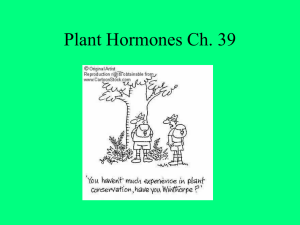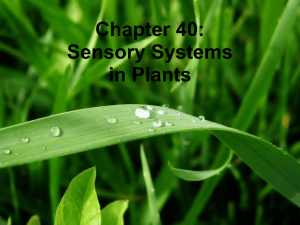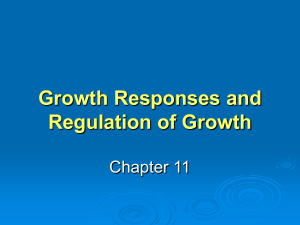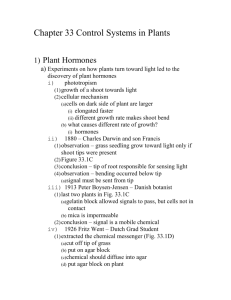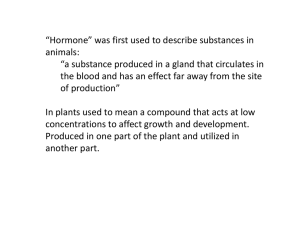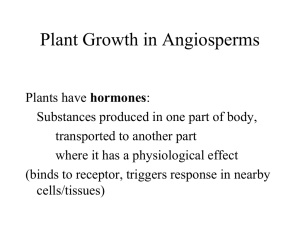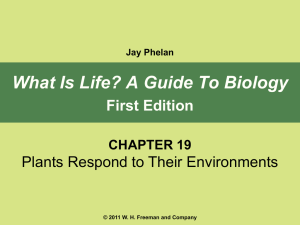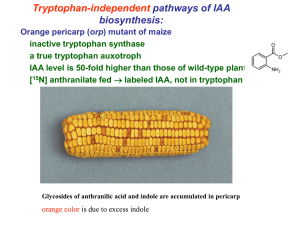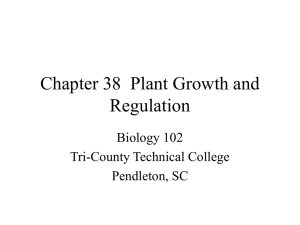Plant Responses
advertisement
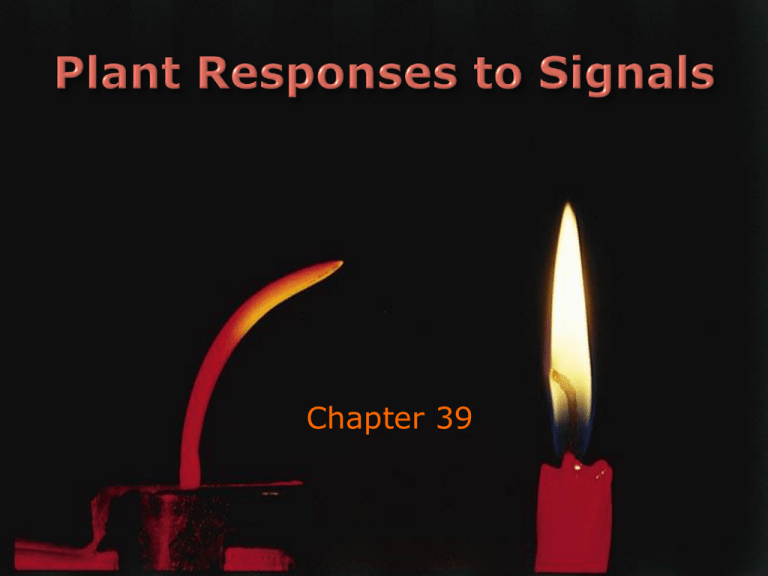
Chapter 39 Examples of some hormones Phototropism experiments Auxin’s mode of action Apical dominance Other tropisms Seed dormancy, germination Fruit ripening Photoperiodism Hormone: a chemical substance produced in one part of the body and has a physiological response in another part of the body at very low concentrations. coordinates metabolic activities active in small amounts Phototropism plants grow towards light Gravitropism- roots grow down into soil statoliths in root cap Thigomotropism- tendrils curl around branch, etc. Responds to touch. wind blowing Darwin and Son, 1880 Boysen-Jensen, 1913 signal moving down from tip Went, 1926 light sensitivity in tip. signal is a chemical substance Thimman isolated the structure of Auxin Differential cell elongation causes stem to bend. Cells on shaded side elongate. How do cells elongate? Auxin in higher concentration on shaded side of stem. Only cells directly underneath stimulated cells elongate Auxin moves basipetally down stem How? Cell wall has constitutive enzymes that loosen connections between cellulose when activated. An increase in cell wall acidity (lower pH) activates the enzymes. Auxin in cytoplasm causes cell wall to acidify. Water moves in by osmosis, swelling cell. Cell membrane lays down additional cell wall material keeping new size / shape How cellulose microfibrils are laid down determine the direct of elongation. Elongation takes place when a cell only has primary cell wall. Once proper size and shape is attained, secondary cell wall material is added inside the primary cell wall. Determines the cell shape higher pH in cytoplasm activates Auxin Can only leave cell via transport proteins at base of cell. Diffuse across into next cell, in inactive form. Entering next cell down, auxin is activated by pH, causing proton pumps to start Cell wall acidifies, activating enzymes. Auxin moves down to next cell. Now more diluted by process Signal fades out farther down Fig. 39-7 RESULTS Cell 1 100 µm Cell 2 Epidermis Cortex Phloem Xylem Pith 25 µm Basal end of cell Statoliths fall to bottom of cell at root cap. Inhibit auxin production in lower cells elongate bending tip downward. Flowers or leaves bend towards sun’s path in the sky during the day. Motor cells at base of flower or leaf uptake K+ and other ions causing them to swell, bending the stem towards light. Stem continues to respond to direction of light during the day, and different cells swell, or relax changing direction. Similar process cause an opening / closing response to flowers (poppies) or Leaves (prayer plants). Can be under circadian rhythm. Shoot apical meristem produces auxin which moves down stem and inhibits auxiliary bud from growing. Roots produce cytokinins that move up and stimulate buds to grow. Pinching back tops makes plants bushier Pruning sends a surge of cytokinins up to remaining buds- fast growth in spring. Limiting root growth can stunt plants. Many annual’s have abscisic acid (ABA) in seed coat. ABA keeps embryo, seed dormant Rains wash out ABA Embryo swells produces gibberillins which cause seed to germinate Ensures germination after soil is wet enough. Other seeds respond to cold, light etc. Fig. 39-12 Early germination in red mangrove Coleoptile Early germination in maize mutant Ethylene is the only gaseous hormone. May spread to other plants Causes fruit to ripen “one bad apple…” Positive feedback loop Apples, bananas not strawberries, mangoes Organic acids convert to sugars, pectin in middle lamella breaks down Ethylene sensitive fruit can be stored green under carbon dioxide for months Gassed before sending to market Potential area for biotechnology Growing tips meets on object Secrete ethylene Causes stem to 1) slow elongation 2) thicken 3) grow sideways Until around object and resumes upward growth. Fig. 39-3 CELL WALL 1 Reception CYTOPLASM 2 Transduction Relay proteins and second messengers 3 Response Activation of cellular responses Receptor Hormone or environmental stimulus Plasma membrane Ethylene mutants Testing in lab dwarfism in many plants Bolting- & flowering Fruit set Stimulate cell division & elongation Promotes seed germination Fig. 39-10 (b) Gibberellin-induced fruit growth (a)Gibberellin-induced stem growth Leaf abscission cause by balance of ethylene and auxin Apoptosis cell death- recycles many essential nutrients to plant, stimulated by burst of ethylene How do plants detect when this should happen? Not covered Table 39-1 Not covered Auxins: growth, cell elongation in stem root, Apical Dominance, seedless fruit Cytokinins: (roots) root growth, stimulates cell differentiation & growth retards senescence (fruit, flower life), stimulates germination Gibberellins; stimulate cell division & elongation, fruit set, bolting, promotes seed germination Ethylene: fruit ripening, opposes some auxin affects Absicisc acid; inhibits growth, closes stomata, dormancy in seeds Oligosaccharins- Trigger defense mechanisms short sugar chains released from cell wall by enzymatic breakdown of cellulose and pectin. Brassinosteroids- steroids required for normal growth and development. Studied mostly by mutations lacking these compounds. Fig. 39-1 Phototropism responds to blue light levels Many responses to light detected by phytochrome sensitive to red light. Seed germination Shade avoidance Need light to germinate Higher PR ratio in shade Plants grows taller to reach brighter light Flower response – Florigen Other photoreceptors sense blue light: phototropism In light Pr converts rapidly to Pfr In dark, Pfr slowly reverts to Pr Used to time amount of darkness, or dawn Resets internal biological clock Actually refer to length of darkness Many plants are day neutral Far red light counteracts red light, erasing “day” signal Fig. 39-23 24 hours 24 hours Long-day plant grafted to short-day plant Long-day plant 24 hours Graft Short-day plant Induced by photoperiod Flowering hormone ? Structure still not discovered may be a macro molecule - CONSTANS protein Can be induced in one plant and move to another Moves cell to cell, slower than phloem Economic significance? Not induced When underground (in darkness) young stems etiolate grow long internodes no leaves produced yellow, no chlorophyll expressed Light detected by phytochrome reverses etiolation, plant sprouts leaves Fig. 39-3 CELL WALL 1 Reception CYTOPLASM 2 Transduction Relay proteins and second messengers 3 Response Activation of cellular responses Receptor Hormone or environmental stimulus Plasma membrane Fig. 39-4-3 1 Reception 2 Transduction 3 CYTOPLASM Plasma membrane cGMP Second messenger produced Specific protein kinase 1 activated Response Transcription factor 1 NUCLEUS P Transcription factor 2 Phytochrome activated by light P Cell wall Specific protein kinase 2 activated Transcription Light Translation Ca2+ channel opened Ca2+ De-etiolation (greening) response proteins Fig. 39-26 (a) Unstimulated state (b) Stimulated state Side of pulvinus With flaccid cells Leaflets after stimulation Pulvinus (motor organ) Side of pulvinus With turgid cells Vein (c) Cross section of a leaflet pair in the stimulated state (LM)
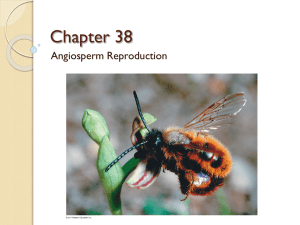
![guide2709.ppt [Compatibility Mode]](http://s3.studylib.net/store/data/008368905_1-88e9b7f8222ebbb87620800faad10ad9-300x300.png)
